

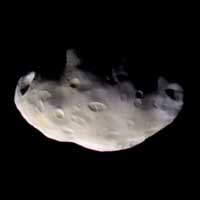
06 Pandora
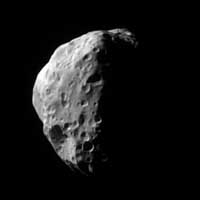
07a Epimetheus
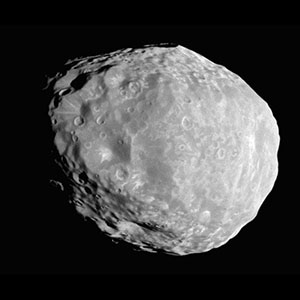
07b Janus
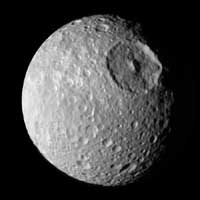
10 Mimas
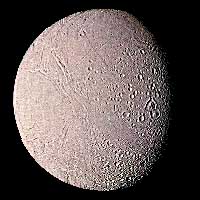
14 Enceladus
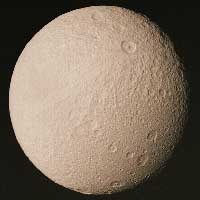
15 Tethys
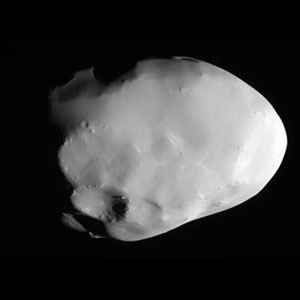
15a Telesto
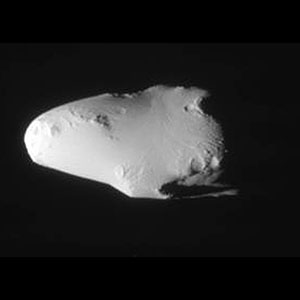
15b Calypso
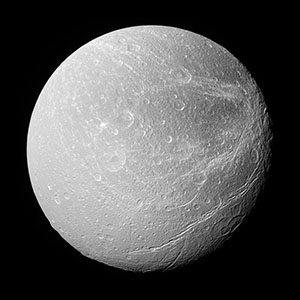
18 Dione
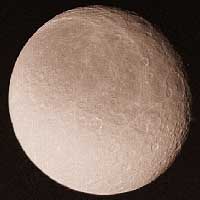
21 Rhea
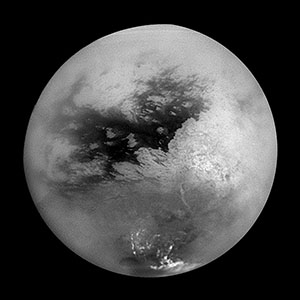
22 Titán
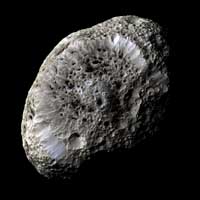
23 Hyperion
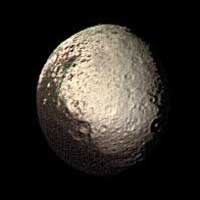
24 Iapetus
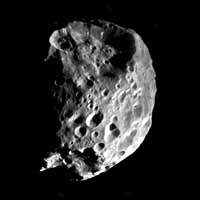
27 Phoebe
Saturn moons
Titan
The 12 children of Uranus and Gaia, the greater Gods, were known as Titans.
Discovered in 1655 by the Dutch astronomer Christiaan Huygens, Titan is the biggest of the 57 known moons orbiting Saturn (till 2006). It is a cold world enclosed by a thick, hazy atmosphere impenetrable by telescopes and cameras.
With an equatorial radius of 2,575 kilometers (1,600 miles), Titan is the second largest moon in our solar system. It's bigger than our own moon and even the planet Mercury. Only Jupiter's moon Ganymede is larger than Titan, with a diameter barely 112 kilometers (62 miles) greater.
The temperature at Titan's surface is about minus 178 degrees C (minus 289 degrees F).
Titan orbits Saturn at a distance of about 1.2 million kilometers (745,000 miles), taking almost 16 days to complete a full orbit - 15.94 days to be exact.
Titan is of great interest to scientists because it is the only moon in the solar system known to have clouds and a mysterious, thick, planet-like atmosphere. In 1980, NASA's Voyager 1 spacecraft tried to take close up images of the natural features of Titan's landscape but was unable to penetrate the thick clouds. Instead, the images showed only slight color and brightness variations in the atmosphere. Titan's atmospheric pressure is about 60 percent greater than Earth's - roughly the same pressure found at the bottom of a swimming pool.
In 1994, NASA's Hubble Space Telescope recorded pictures of Titan, which suggested that a huge bright "continent" exists on the hemisphere that faces forward in orbit. These Hubble results don't prove that liquid "seas" exist, however; only that Titan has large bright and dark regions on its surface.
NASA's Cassini-Huygens spacecraft (currently orbiting Saturn) should shed new light on Titan's mysteries. The spacecraft's instruments are designed to reveal many of Titan's characteristics. During dozens of flybys, the Cassini orbiter will map Titan with cloud-penetrating radar and collect atmospheric data. The Huygens probe dove through Titan's dense atmosphere on Jan. 14, 2005 with instruments capable of analyzing its components.
Combined with the "big picture" information that the Cassini orbiter will collect during Titan flybys, data from the Huygens probe will provide scientists with critical information that may shed light on ancient questions such as "Where did we come from?" And, "How did the planets form?"
Because of the extremely cold temperatures typical of celestial bodies that are that far away from the Sun, the structure of Titan's chemical atmosphere is in a state of deep freeze. It is this chemical composition that interests scientists a great deal because Titan's atmosphere might consist of compounds similar to those present in the primordial days of the Earth's atmosphere. Titan's thick cloudy atmosphere is mostly nitrogen, like Earth's, but may contain much higher percentages of "smog-like" chemicals such as methane and ethane. The smog may be so thick that it actually rains "gasoline-like" liquids. The organic nature of some of the chemicals found in Titan's atmosphere might indicate that this fascinating moon could harbor some form of life.
Rhea
The second largest moon of Saturn. It was discovered on Dec. 23, 1672, by Giovanni Cassini and is also known as Saturn V. Rhea appears to resemble Dione in composition, albedo features, and variety of terrain. It probably has a rocky core extending out to about one third of the way from the center, the rest of the moon being composed primarily of water ice.
Rhea is one of the most heavily cratered satellites in the solar system. It also displays bright, wispy markings. Of the two main types of terrain present, one contains craters up to and exceeding 40 km (25 miles) in diameter; the other, in parts of the polar and equatorial regions, has no craters larger than 40 km. This suggests that a major resurfacing event took place early in the moon's geological history.
The leading hemisphere of Rhea is heavily cratered and uniformly bright. As on Callisto, the craters lack the high relief features seen on the Moon and Mercury. The trailing hemisphere displays a network of bright swaths on a dark background and few visible craters. It had been thought that these bright swaths might consist of material thrown out of ice volcanoes in Rhea's ancient past when the moon still had a liquid interior. However, recent observations of Dione, which has an even darker trailing hemisphere and similar but more prominent bright streaks, have shown that the streaks are ice cliffs, and it seems reasonable to assume that this is also the case on Rhea.
Iapetus
An outer moon of Saturn, also known as Saturn VII, remarkable in that its brightness changes by a factor of seven as it moves around its orbit. Whereas the leading hemisphere of the moon is as dark as asphalt with a slight reddish color, the trailing hemisphere is very bright. In December 2004, the Cassini spacecraft discovered a further extraordinary feature of Iapetus: a topographic ridge that coincides almost exactly with the geographic equator. The ridge is conspicuous in the image above as an approximately 20-km wide (12 miles) band that extends from the western (left) side of the disk almost to the day/night boundary on the right. On the left horizon, the peak of the ridge reaches at least 13 km (8 miles) above the surrounding terrain. Along the roughly 1,300 km (800 mile) length over which it can be traced in this picture, it remains almost exactly parallel to the equator within a couple of degrees. The physical origin of the ridge has yet to be explained. It is not yet clear whether the ridge is a mountain belt that has folded upward, or an extensional crack in the surface through which material from inside Iapetus erupted onto the surface and accumulated locally, forming the ridge.
Dione
The fourth-largest moon of Saturn and the third densest after Titan and Enceladus. It was discovered on Mar. 21, 1684, by Giovanni Cassini and is also known as Saturn IV. Dione's relatively high density suggests that it has a rocky core, making up about one third of its total mass, surrounded by water ice. In composition, albedo, and terrain, it is similar to Rhea. Both moons have markedly different leading and trailing hemispheres. The surface includes heavily-cratered terrain, moderately cratered plains, lightly cratered plains, and bright, wispy material. The heavily-cratered regions feature craters of all diameters up to and exceeding 100 kilometers (60 miles), whereas the plains areas tend to have craters no larger than about 30 km across.
Contrary to what might be expected of a satellite in gravitational lock, it is the trailing hemisphere of Dione on which the majority of intense cratering exists. This suggests that, during the early period of heavy bombardment in the solar system, Dione was tidally locked to Saturn in the opposite direction to which it now spins. Subsequent major collisions with any objects large enough to cause craters more than about 35 km (21 miles) in diameter, of which there are many on Dione, would have been capable of altering the rate and direction of the moon's rotation. The likelihood is that Dione has been tidally locked in its current state for several billion years judging by the average albedo of the leading and trailing hemispheres. The albedo decreases from the leading to the trailing hemisphere since the former has suffered a higher rate of micrometeorite impacts. Streaks of bright material which interlace a dark portion of the surface are of uncertain origin but may be fractures associated with faults through which water has upwelled.
Tethys
The fifth largest moon of Saturn. It was discovered by Giovanni Cassini on Mar. 21, 1684, and is also known as Saturn III.
Tethys appears to be composed primarily of water ice and is marked by a huge, globe-encircling canyon and numerous impact craters. The giant canyon, named Ithaca Chasma, is about 2,500 km (1,550 miles) long (three quarters of the circumference of the moon), and has an average width of about 65 km (40 miles) and a depth of 3 to 5 km (about 2 to 3 miles). If Tethys were once a ball of liquid water covered with a thin, solid crust, freezing of a thick, watery mantle would have produced enough surface expansion to account for the area of the trough. But it is unclear why all the expansion would have taken place in a single band rather than in widely distributed faults. Also prominent is a large crater, Odysseus, about 400 km (250 miles) across, or more than one third of the diameter of Tethys. A line drawn through the center of Odysseus would lie roughly at right-angles to Ithaca Chasma, suggesting a possible link between the two features. The temperature on the surface is -187°C (-305°F).
Enceladus
Enceladus is one of the innermost moons of Saturn. It is quite similar in size to Mimas but has a smoother, brighter surface. Enceladus reflects almost 100 percent of the sunlight that strikes it. Unlike Mimas, Enceladus displays at least five different types of terrain. Parts of Enceladus shows craters no larger than 35 km in diameter. Other areas show regions with no craters indicating major resurfacing events in the geologically recent past. There are fissures, plains, corrugated terrain and other crustal deformations. All of this indicates that the interior of the moon may be liquid today, even though it should have frozen aeons ago. It is postulated that Enceladus is heated by a tidal mechanism similar to Jupiter's moon Io. It is perturbed in its orbit by Saturn's gravitational field and by the large neighboring satellites Tethys and Dione.
Because Enceladus reflects so much sunlight, the surface temperature is only -201° C (-330° F).
Since early 2005, the Cassini-Huygens Mission to Saturn has uncovered many mysteries about Enceladus. Below is a discovery timeline for this intriguing moon.
February and March 2005
Cassini's magnetometer discovers an atmosphere around Enceladus, evidence that gases may be originating from the moon's surface or interior.
The cosmic dust analyzer records thousands of hits from tiny particles of dust or ice, possibly coming from a cloud around the moon or from the adjacent E ring.
July 2005
Warm Fractures on Enceladus
The imaging team sees unusual geology on the moon's southern pole, including house-sized ice boulders and evidence of recent geological activity.
The visual and infrared mapping spectrometer determines that the large dark cracks, called "tiger stripes," at the south pole are very young and seem to have a continual supply of fresh ice.
The composite infrared spectrometer shows that the south pole is much warmer than expected, suggesting an internal heat source.
The ion and neutral mass spectrometer and the ultraviolet imaging spectrograph detect water vapor in the atmosphere, which appears to come from a localized source.
The cosmic dust analyzer detects a large increase in the number of particles near Enceladus, confirming that Enceladus is the source of Saturn's E ring.
November 2005
Spray Above Enceladus
Cassini's visual and infrared mapping spectrometer measures the spectrum of the plumes originating from the south pole of the icy moon, capturing a very clear signature of small ice particles.
The imaging team produces the first pictures of the plume of icy material streaming from Enceladus' south pole, possible evidence of Yellowstone-like geysers fed by reservoirs of liquid water.
Mimas
A moon of Saturn, discovered on Sep. 17, 1789, by William Herschel. It is also known as Saturn I because it was the innermost of the seven moons of Saturn known when this numbering system was adopted. In Greek mythology, Mimas was a Titan who was slain by the god Hercules. Its low density suggests a composition that is primarily water ice. Mimas is heavily cratered, although the cratering is not uniform. While most of the surface is covered with craters up to and exceeding 40 km (25 miles) in diameter, in the southern polar region craters larger than 20 km (12 miles) are generally absent. Preeminent is the crater Herschel which, at 130 km (80 miles) across, spans more than one third the diameter of the whole moon, and has a central peak that rises 6 km (4 miles) above the crater floor. Had the impact that caused it been much bigger, it may have split Mimas apart. As it is, traces of fracture marks are evident on the opposite hemisphere. Most of the other craters on Mimas are named after characters in Camelot. From a distance, the satellite bears a striking resemblance to the Death Star in the Star Wars films.
| Confirmed moons 2021 | |||||||||
| Nº | Name | Diam. km | Mass (×1015 kg) |
Semi-mayor axis-km |
Orbital period | Inclin. | Eccentri. | Discovery | by |
| 1 | •S/2009 S1 | ≈ 0.3 | < 0.0001 | ≈ 117000 | ≈ 0.47000 | ≈ 0.000 | ≈ 0.0000 | 2009 | Cassini H* |
| (moonlets) | 0.04 to 0.4 | < 0.0001 | ≈ 130000 | ≈ 0.55000 | ≈ 0.000 | ≈ 0.0000 | 2006 | Cassini H | |
| 2 | •Pan | 28.2 | 4.95 | 133584 | 0.57505 | ≈ 0.000 | ≈ 0.0000 | 1990 | Showalter |
| 3 | •Daphnis | 7.6 | 0.084 | 136505 | 0.59408 | 0.004 | ≈ 0.0000 | 2005 | Cassini H |
| 4 | •Atlas | 30.2 | 6.6 | 137670 | 0.60169 | 0.003 | 0.0012 | 1980 | Voyager 1 |
| 5 | •Prometheus | 86.2 | 159.5 | 139380 | 0.61299 | 0.008 | 0.0022 | 1980 | Voyager 1 |
| 6 | •Pandora | 81.4 | 137.1 | 141720 | 0.6285 | 0.05 | 0.0042 | 1980 | Voyager 1 |
| 7a | •Epimetheus | 116.2 | 526.6 | 151422 | 0.69433 | 0.335 | 0.0098 | 1977 | Fountain & Larson |
| 7b | •Janus | 179 | 1897.5 | 151472 | 0.69466 | 0.165 | 0.0068 | 1966 | Dollfus |
| 9 | •Aegaeon | 0.66 | ≈ 0.0001 | 167500 | 0.80812 | 0.001 | 0.0004 | 2008 | Cassini H |
| 10 | †Mimas | 396.4 | 37493 | 185404 | 0.94242 | 1.566 | 0.0202 | 1789 | Herschel |
| 11 | •Methone | 2.9 | ≈ 0.02 | 194440 | 1.00957 | 0.007 | 0.0001 | 2004 | Cassini H |
| 12 | •Anthe | 1.8 | ≈ 0.0015 | 197700 | 1.05089 | 0.1 | 0.0011 | 2007 | Cassini H |
| 13 | •Pallene | 4.44 | ≈ 0.05 | 212280 | 1.15375 | 0.181 | 0.004 | 2004 | Cassini H |
| 14 | †Enceladus | 504.2 | 108022 | 237950 | 1.37022 | 0.01 | 0.0047 | 1789 | Herschel |
| 15 | †Tethys | 1062.2 | 617449 | 294619 | 1.8878 | 0.168 | 0.0001 | 1684 | G. Cassini* |
| 15a | •Telesto | 24.8 | ≈ 9.41 | 294619 | 1.8878 | 1.158 | 0 | 1980 | Smith et al. |
| 15b | •Calypso | 21.4 | ≈ 6.3 | 294619 | 1.8878 | 1.473 | 0 | 1980 | Pascu et al. |
| 18 | †Dione | 1122.8 | 1095452 | 377396 | 2.73692 | 0.002 | 0.0022 | 1684 | G. Cassini |
| 18a | •Helene | 35.2 | ≈ 24.5 | 377396 | 2.73692 | 0.199 | 0.0022 | 1980 | Laques & Lecacheux |
| 18b | •Polydeuces | 2.6 | ≈ 0.03 | 377396 | 2.73692 | 0.177 | 0.0192 | 2004 | Cassini H |
| 21 | †Rhea | 1527.6 | 2306518 | 527108 | 4.51821 | 0.327 | 0.0013 | 1672 | G. Cassini |
| 22 | ♠Titan | 5149.46 | 1.35E+08 | 1221930 | 15.9454 | 0.349 | 0.0288 | 1655 | Huygens |
| 23 | •Hyperion | 270 | 5619.9 | 1481010 | 21.2766 | 0.568 | 0.123 | 1848 | Bond & Lassell |
| 24 | †Iapetus | 1468.6 | 1805635 | 3560820 | 79.3215 | 15.47 | 0.0286 | 1671 | G. Cassini |
| 25 | ‡Kiviuq | ≈ 17 | ≈ 2.79 | 11307500 | 448.91 | 48.93 | 0.1521 | 2000 | Gladman et al. |
| 26 | ‡Ijiraq | ≈ 13 | ≈ 1.18 | 11348500 | 451.36 | 49.51 | 0.3758 | 2000 | Gladman et al. |
| 27 | ♣Phoebe | 213 | 8292 | 12905900 | −547.39 | 172.998 | 0.1604 | 1899 | Pickering |
| 28 | ‡Paaliaq | ≈ 25 | ≈ 7.25 | 15012800 | 686.75 | 43.688 | 0.4826 | 2000 | Gladman et al. |
| 29 | ♣Skathi | ≈ 8 | ≈ 0.35 | 15563600 | −724.90 | 149.749 | 0.2755 | 2000 | Gladman et al. |
| 30 | ♣S/2004 S 37 | ≈ 4 | ≈ 0.05 | 15822400 | −743.06 | 163.046 | 0.5265 | 2019 (2004) | Sheppard et al. |
| 31 | ♣S/2007 S 2 | ≈ 6 | ≈ 0.15 | 15971500 | −753.58 | 176.676 | 0.2465 | 2007 | Sheppard et al. |
| 32 | ♦Albiorix | 28.6 | ≈ 22.3 | 16222700 | 771.43 | 34.559 | 0.5807 | 2000 | Holman |
| 33 | ♦Bebhionn | ≈ 6 | ≈ 0.15 | 16900900 | 820.31 | 40.124 | 0.3813 | 2004 | Sheppard et al. |
| 34 | ‡S/2004 S 29 | ≈ 4 | ≈ 0.05 | 17202800 | 842.39 | 46.2 | 0.4269 | 2019 (2004) | Sheppard et al. |
| 35 | ♣Skoll | ≈ 5 | ≈ 0.15 | 17438300 | −859.75 | 157.143 | 0.4402 | 2006 | Sheppard et al. |
| 36 | ‡S/2004 S 31 | ≈ 4 | ≈ 0.05 | 17449700 | 860.58 | 47.782 | 0.2525 | 2019 (2004) | Sheppard et al. |
| 37 | ♦Erriapus | ≈ 10 | ≈ 0.68 | 17705500 | 879.58 | 41.72 | 0.452 | 2000 | Gladman et al. |
| 38 | ‡Tarqeq | ≈ 7 | ≈ 0.23 | 17724200 | 880.97 | 50.159 | 0.1373 | 2007 | Sheppard et al. |
| 39 | ‡Siarnaq | 39.3 | ≈ 43.5 | 17937000 | 883.87 | 43.799 | 0.5293 | 2000 | Gladman et al. |
| 40 | ♦Tarvos | ≈ 15 | ≈ 2.3 | 18243800 | 920 | 37.818 | 0.4799 | 2000 | Gladman et al. |
| 41 | ♣Hyrrokkin | ≈ 8 | ≈ 0.35 | 18348800 | −927.95 | 153.539 | 0.3582 | 2004 | Sheppard et al. |
| 42 | ♣Greip | ≈ 5 | ≈ 0.15 | 18379000 | −930.24 | 172.88 | 0.3331 | 2006 | Sheppard et al. |
| 43 | ♣Mundilfari | ≈ 7 | ≈ 0.23 | 18470800 | −937.22 | 169.663 | 0.1787 | 2000 | Gladman et al. |
| 44 | ♣S/2004 S 13 | ≈ 6 | ≈ 0.15 | 18594700 | −946.67 | 167.041 | 0.29 | 2004 | Sheppard et al. |
| 45 | ♣S/2006 S 1 | ≈ 5 | ≈ 0.15 | 18839700 | −965.44 | 154.904 | 0.0972 | 2006 | Sheppard et al. |
| 46 | ♣S/2007 S 3 | ≈ 5 | ≈ 0.09 | 19143500 | −988.89 | 177.065 | 0.1671 | 2007 | Sheppard et al. |
| 47 | ♣Suttungr | ≈ 7 | ≈ 0.23 | 19166800 | −990.69 | 174.091 | 0.1445 | 2000 | Gladman et al. |
| 48 | ♣S/2004 S 20 | ≈ 4 | ≈ 0.05 | 19188100 | −992.34 | 162.782 | 0.1976 | 2019 (2004) | Sheppard et al. |
| 49 | ♣Jarnsaxa | ≈ 6 | ≈ 0.15 | 19197900 | −993.11 | 163.78 | 0.2148 | 2006 | Sheppard et al. |
| 50 | ♣Narvi | ≈ 7 | ≈ 0.23 | 19226600 | −995.33 | 136.803 | 0.299 | 2003 | Sheppard et al. |
| 51 | ♣Bergelmir | ≈ 5 | ≈ 0.15 | 19290200 | −1000.28 | 156.919 | 0.1399 | 2004 | Sheppard et al. |
| 52 | ♣Hati | ≈ 5 | ≈ 0.15 | 19435300 | −1011.59 | 164 | 0.3295 | 2004 | Sheppard et al. |
| 53 | ♣S/2004 S 17 | ≈ 4 | ≈ 0.05 | 19574300 | −1022.45 | 167.936 | 0.1916 | 2004 | Sheppard et al. |
| 54 | ♣S/2004 S 12 | ≈ 5 | ≈ 0.09 | 19736400 | −1035.18 | 163.797 | 0.3929 | 2004 | Sheppard et al. |
| 55 | ♣S/2004 S 27 | ≈ 6 | ≈ 0.15 | 19982800 | −1054.63 | 167.707 | 0.1364 | 2019 (2004) | Sheppard et al. |
| 56 | ♣Farbauti | ≈ 5 | ≈ 0.09 | 20101600 | −1064.04 | 157.484 | 0.1756 | 2004 | Sheppard et al. |
| 57 | ♣Thrymr | ≈ 8 | ≈ 0.23 | 20236700 | −1074.79 | 174.177 | 0.4332 | 2000 | Gladman et al. |
| 58 | ♣Bestla | ≈ 7 | ≈ 0.23 | 20432100 | −1090.39 | 143.955 | 0.7072 | 2004 | Sheppard et al. |
| 59 | ♣S/2004 S 7 | ≈ 6 | ≈ 0.15 | 20576700 | −1091.09 | 164.331 | 0.4998 | 2004 | Sheppard et al. |
| 60 | ♣Aegir | ≈ 6 | ≈ 0.15 | 20598900 | −1103.78 | 166.671 | 0.2379 | 2004 | Sheppard et al. |
| 61 | ♣S/2004 S 30 | ≈ 3 | ≈ 0.03 | 20733300 | −1114.59 | 157.121 | 0.0859 | 2019 (2004) | Sheppard et al. |
| 62 | ♣S/2004 S 22 | ≈ 3 | ≈ 0.03 | 20737100 | −1114.90 | 177.285 | 0.2369 | 2019 (2004) | Sheppard et al. |
| 63 | ♣S/2004 S 25 | ≈ 4 | ≈ 0.05 | 20814800 | −1121.17 | 172.938 | 0.4362 | 2019 (2004) | Sheppard et al. |
| 64 | ♣S/2004 S 32 | ≈ 4 | ≈ 0.05 | 20963400 | −1133.20 | 159.261 | 0.2594 | 2019 (2004) | Sheppard et al. |
| 65 | ♣S/2004 S 23 | ≈ 4 | ≈ 0.05 | 21444300 | −1172.42 | 176.854 | 0.4133 | 2019 (2004) | Sheppard et al. |
| 66 | ♣S/2006 S 3 | ≈ 6 | ≈ 0.15 | 21607300 | −1185.81 | 152.958 | 0.4533 | 2006 | Sheppard et al. |
| 67 | ♣S/2004 S 35 | ≈ 6 | ≈ 0.15 | 21864500 | −1207.04 | 176.771 | 0.203 | 2019 (2004) | Sheppard et al. |
| 68 | ♣Kari | ≈ 6 | ≈ 0.23 | 21988000 | −1217.28 | 149.188 | 0.3745 | 2006 | Sheppard et al. |
| 69 | ♣S/2004 S 28 | ≈ 4 | ≈ 0.05 | 22134400 | −1229.46 | 170.617 | 0.1249 | 2019 (2004) | Sheppard et al. |
| 70 | ♣Loge | ≈ 5 | ≈ 0.15 | 22563800 | −1265.42 | 166.811 | 0.1584 | 2006 | Sheppard et al. |
| 71 | ♣S/2004 S 38 | ≈ 4 | ≈ 0.05 | 22616000 | −1269.81 | 154.654 | 0.4084 | 2019 (2004) | Sheppard et al. |
| 72 | ♣Fenrir | ≈ 4 | ≈ 0.05 | 22753400 | −1281.39 | 162.874 | 0.0949 | 2004 | Sheppard et al. |
| 73 | ♣Ymir | ≈ 19 | ≈ 3.97 | 22841900 | −1288.88 | 172.157 | 0.3431 | 2000 | Gladman et al. |
| 74 | ♣Surtur | ≈ 6 | ≈ 0.15 | 23065900 | −1307.89 | 166.008 | 0.3591 | 2006 | Sheppard et al. |
| 75 | ♣S/2004 S 33 | ≈ 4 | ≈ 0.05 | 23087600 | −1309.73 | 159.866 | 0.4113 | 2019 (2004) | Sheppard et al. |
| 76 | ♦S/2004 S 24 | ≈ 3 | ≈ 0.03 | 23326300 | 1330.1 | 36.24 | 0.04 | 2019 (2004) | Sheppard et al. |
| 77 | ♣S/2004 S 21 | ≈ 3 | ≈ 0.03 | 23356200 | −1332.66 | 156.2 | 0.3156 | 2019 (2004) | Sheppard et al. |
| 78 | ♣S/2004 S 39 | ≈ 3 | ≈ 0.03 | 23463800 | −1341.87 | 166.578 | 0.0979 | 2019 (2004) | Sheppard et al. |
| 79 | ♣S/2004 S 36 | ≈ 3 | ≈ 0.03 | 23576500 | −1351.56 | 155.188 | 0.7139 | 2019 (2004) | Sheppard et al. |
| 80 | ♣Fornjot | ≈ 6 | ≈ 0.15 | 24451700 | −1427.51 | 167.847 | 0.1613 | 2004 | Sheppard et al. |
| 81 | ♣S/2004 S 34 | ≈ 3 | ≈ 0.03 | 24865000 | −1463.85 | 166.039 | 0.2015 | 2019 (2004) | Sheppard et al. |
| 82 | ♣S/2004 S 26 | ≈ 4 | ≈ 0.05 | 26701600 | −1628.99 | 171.575 | 0.1726 | 2019 (2004) | Sheppard et al. |
* "Cassini H" refers to the spacecraft. "G. Cassini" refers to the astronomer Giovanni Domenico Cassini |
|||||||||
| Confirmed moons 2021 - A | |||||
| Nº | Name | Diam. km | Mass (×1015 kg) |
Semi-mayor axis - km |
Orbital period |
| 1 | •S/2009 S1 | ≈ 0.3 | < 0.0001 | ≈ 117000 | ≈ 0.47000 |
| (moonlets) | 0.04 to 0.4 | < 0.0001 | ≈ 130000 | ≈ 0.55000 | |
| 2 | •Pan | 28.2 | 4.95 | 133584 | 0.57505 |
| 3 | •Daphnis | 7.6 | 0.084 | 136505 | 0.59408 |
| 4 | •Atlas | 30.2 | 6.6 | 137670 | 0.60169 |
| 5 | •Prometheus | 86.2 | 159.5 | 139380 | 0.61299 |
| 6 | •Pandora | 81.4 | 137.1 | 141720 | 0.6285 |
| 7a | •Epimetheus | 116.2 | 526.6 | 151422 | 0.69433 |
| 7b | •Janus | 179 | 1897.5 | 151472 | 0.69466 |
| 9 | •Aegaeon | 0.66 | ≈ 0.0001 | 167500 | 0.80812 |
| 10 | †Mimas | 396.4 | 37493 | 185404 | 0.94242 |
| 11 | •Methone | 2.9 | ≈ 0.02 | 194440 | 1.00957 |
| 12 | •Anthe | 1.8 | ≈ 0.0015 | 197700 | 1.05089 |
| 13 | •Pallene | 4.44 | ≈ 0.05 | 212280 | 1.15375 |
| 14 | †Enceladus | 504.2 | 108022 | 237950 | 1.37022 |
| 15 | †Tethys | 1062.2 | 617449 | 294619 | 1.8878 |
| 15a | •Telesto | 24.8 | ≈ 9.41 | 294619 | 1.8878 |
| 15b | •Calypso | 21.4 | ≈ 6.3 | 294619 | 1.8878 |
| 18 | †Dione | 1122.8 | 1095452 | 377396 | 2.73692 |
| 18a | •Helene | 35.2 | ≈ 24.5 | 377396 | 2.73692 |
| 18b | •Polydeuces | 2.6 | ≈ 0.03 | 377396 | 2.73692 |
| 21 | †Rhea | 1527.6 | 2306518 | 527108 | 4.51821 |
| 22 | ♠Titan | 5149.46 | 1.35E+08 | 1221930 | 15.9454 |
| 23 | •Hyperion | 270 | 5619.9 | 1481010 | 21.2766 |
| 24 | †Iapetus | 1468.6 | 1805635 | 3560820 | 79.3215 |
| 25 | ‡Kiviuq | ≈ 17 | ≈ 2.79 | 11307500 | 448.91 |
| 26 | ‡Ijiraq | ≈ 13 | ≈ 1.18 | 11348500 | 451.36 |
| 27 | ♣Phoebe | 213 | 8292 | 12905900 | −547.39 |
| 28 | ‡Paaliaq | ≈ 25 | ≈ 7.25 | 15012800 | 686.75 |
| 29 | ♣Skathi | ≈ 8 | ≈ 0.35 | 15563600 | −724.90 |
| 30 | ♣S/2004 S 37 | ≈ 4 | ≈ 0.05 | 15822400 | −743.06 |
| 31 | ♣S/2007 S 2 | ≈ 6 | ≈ 0.15 | 15971500 | −753.58 |
| 32 | ♦Albiorix | 28.6 | ≈ 22.3 | 16222700 | 771.43 |
| 33 | ♦Bebhionn | ≈ 6 | ≈ 0.15 | 16900900 | 820.31 |
| 34 | ‡S/2004 S 29 | ≈ 4 | ≈ 0.05 | 17202800 | 842.39 |
| 35 | ♣Skoll | ≈ 5 | ≈ 0.15 | 17438300 | −859.75 |
| 36 | ‡S/2004 S 31 | ≈ 4 | ≈ 0.05 | 17449700 | 860.58 |
| 37 | ♦Erriapus | ≈ 10 | ≈ 0.68 | 17705500 | 879.58 |
| 38 | ‡Tarqeq | ≈ 7 | ≈ 0.23 | 17724200 | 880.97 |
| 39 | ‡Siarnaq | 39.3 | ≈ 43.5 | 17937000 | 883.87 |
| 40 | ♦Tarvos | ≈ 15 | ≈ 2.3 | 18243800 | 920 |
| 41 | ♣Hyrrokkin | ≈ 8 | ≈ 0.35 | 18348800 | −927.95 |
| 42 | ♣Greip | ≈ 5 | ≈ 0.15 | 18379000 | −930.24 |
| 43 | ♣Mundilfari | ≈ 7 | ≈ 0.23 | 18470800 | −937.22 |
| 44 | ♣S/2004 S 13 | ≈ 6 | ≈ 0.15 | 18594700 | −946.67 |
| 45 | ♣S/2006 S 1 | ≈ 5 | ≈ 0.15 | 18839700 | −965.44 |
| 46 | ♣S/2007 S 3 | ≈ 5 | ≈ 0.09 | 19143500 | −988.89 |
| 47 | ♣Suttungr | ≈ 7 | ≈ 0.23 | 19166800 | −990.69 |
| 48 | ♣S/2004 S 20 | ≈ 4 | ≈ 0.05 | 19188100 | −992.34 |
| 49 | ♣Jarnsaxa | ≈ 6 | ≈ 0.15 | 19197900 | −993.11 |
| 50 | ♣Narvi | ≈ 7 | ≈ 0.23 | 19226600 | −995.33 |
| 51 | ♣Bergelmir | ≈ 5 | ≈ 0.15 | 19290200 | −1000.28 |
| 52 | ♣Hati | ≈ 5 | ≈ 0.15 | 19435300 | −1011.59 |
| 53 | ♣S/2004 S 17 | ≈ 4 | ≈ 0.05 | 19574300 | −1022.45 |
| 54 | ♣S/2004 S 12 | ≈ 5 | ≈ 0.09 | 19736400 | −1035.18 |
| 55 | ♣S/2004 S 27 | ≈ 6 | ≈ 0.15 | 19982800 | −1054.63 |
| 56 | ♣Farbauti | ≈ 5 | ≈ 0.09 | 20101600 | −1064.04 |
| 57 | ♣Thrymr | ≈ 8 | ≈ 0.23 | 20236700 | −1074.79 |
| 58 | ♣Bestla | ≈ 7 | ≈ 0.23 | 20432100 | −1090.39 |
| 59 | ♣S/2004 S 7 | ≈ 6 | ≈ 0.15 | 20576700 | −1091.09 |
| 60 | ♣Aegir | ≈ 6 | ≈ 0.15 | 20598900 | −1103.78 |
| 61 | ♣S/2004 S 30 | ≈ 3 | ≈ 0.03 | 20733300 | −1114.59 |
| 62 | ♣S/2004 S 22 | ≈ 3 | ≈ 0.03 | 20737100 | −1114.90 |
| 63 | ♣S/2004 S 25 | ≈ 4 | ≈ 0.05 | 20814800 | −1121.17 |
| 64 | ♣S/2004 S 32 | ≈ 4 | ≈ 0.05 | 20963400 | −1133.20 |
| 65 | ♣S/2004 S 23 | ≈ 4 | ≈ 0.05 | 21444300 | −1172.42 |
| 66 | ♣S/2006 S 3 | ≈ 6 | ≈ 0.15 | 21607300 | −1185.81 |
| 67 | ♣S/2004 S 35 | ≈ 6 | ≈ 0.15 | 21864500 | −1207.04 |
| 68 | ♣Kari | ≈ 6 | ≈ 0.23 | 21988000 | −1217.28 |
| 69 | ♣S/2004 S 28 | ≈ 4 | ≈ 0.05 | 22134400 | −1229.46 |
| 70 | ♣Loge | ≈ 5 | ≈ 0.15 | 22563800 | −1265.42 |
| 71 | ♣S/2004 S 38 | ≈ 4 | ≈ 0.05 | 22616000 | −1269.81 |
| 72 | ♣Fenrir | ≈ 4 | ≈ 0.05 | 22753400 | −1281.39 |
| 73 | ♣Ymir | ≈ 19 | ≈ 3.97 | 22841900 | −1288.88 |
| 74 | ♣Surtur | ≈ 6 | ≈ 0.15 | 23065900 | −1307.89 |
| 75 | ♣S/2004 S 33 | ≈ 4 | ≈ 0.05 | 23087600 | −1309.73 |
| 76 | ♦S/2004 S 24 | ≈ 3 | ≈ 0.03 | 23326300 | 1330.1 |
| 77 | ♣S/2004 S 21 | ≈ 3 | ≈ 0.03 | 23356200 | −1332.66 |
| 78 | ♣S/2004 S 39 | ≈ 3 | ≈ 0.03 | 23463800 | −1341.87 |
| 79 | ♣S/2004 S 36 | ≈ 3 | ≈ 0.03 | 23576500 | −1351.56 |
| 80 | ♣Fornjot | ≈ 6 | ≈ 0.15 | 24451700 | −1427.51 |
| 81 | ♣S/2004 S 34 | ≈ 3 | ≈ 0.03 | 24865000 | −1463.85 |
| 82 | ♣S/2004 S 26 | ≈ 4 | ≈ 0.05 | 26701600 | −1628.99 |
| Confirmed moons 2021 -B | |||||
| Nº | Name | Inclin. | Eccentri. | Discovery | by |
| 1 | •S/2009 S1 | ≈ 0.000 | ≈ 0.0000 | 2009 | Cassini H* |
| (moonlets) | ≈ 0.000 | ≈ 0.0000 | 2006 | Cassini H | |
| 2 | •Pan | ≈ 0.000 | ≈ 0.0000 | 1990 | Showalter |
| 3 | •Daphnis | 0.004 | ≈ 0.0000 | 2005 | Cassini H |
| 4 | •Atlas | 0.003 | 0.0012 | 1980 | Voyager 1 |
| 5 | •Prometheus | 0.008 | 0.0022 | 1980 | Voyager 1 |
| 6 | •Pandora | 0.05 | 0.0042 | 1980 | Voyager 1 |
| 7a | •Epimetheus | 0.335 | 0.0098 | 1977 | Fountain & Larson |
| 7b | •Janus | 0.165 | 0.0068 | 1966 | Dollfus |
| 9 | •Aegaeon | 0.001 | 0.0004 | 2008 | Cassini H |
| 10 | †Mimas | 1.566 | 0.0202 | 1789 | Herschel |
| 11 | •Methone | 0.007 | 0.0001 | 2004 | Cassini H |
| 12 | •Anthe | 0.1 | 0.0011 | 2007 | Cassini H |
| 13 | •Pallene | 0.181 | 0.004 | 2004 | Cassini H |
| 14 | †Enceladus | 0.01 | 0.0047 | 1789 | Herschel |
| 15 | †Tethys | 0.168 | 0.0001 | 1684 | G. Cassini* |
| 15a | •Telesto | 1.158 | 0 | 1980 | Smith et al. |
| 15b | •Calypso | 1.473 | 0 | 1980 | Pascu et al. |
| 18 | †Dione | 0.002 | 0.0022 | 1684 | G. Cassini |
| 18a | •Helene | 0.199 | 0.0022 | 1980 | Laques & Lecacheux |
| 18b | •Polydeuces | 0.177 | 0.0192 | 2004 | Cassini H |
| 21 | †Rhea | 0.327 | 0.0013 | 1672 | G. Cassini |
| 22 | ♠Titan | 0.349 | 0.0288 | 1655 | Huygens |
| 23 | •Hyperion | 0.568 | 0.123 | 1848 | Bond & Lassell |
| 24 | †Iapetus | 15.47 | 0.0286 | 1671 | G. Cassini |
| 25 | ‡Kiviuq | 48.93 | 0.1521 | 2000 | Gladman et al. |
| 26 | ‡Ijiraq | 49.51 | 0.3758 | 2000 | Gladman et al. |
| 27 | ♣Phoebe | 172.998 | 0.1604 | 1899 | Pickering |
| 28 | ‡Paaliaq | 43.688 | 0.4826 | 2000 | Gladman et al. |
| 29 | ♣Skathi | 149.749 | 0.2755 | 2000 | Gladman et al. |
| 30 | ♣S/2004 S 37 | 163.046 | 0.5265 | 2019 (2004) | Sheppard et al. |
| 31 | ♣S/2007 S 2 | 176.676 | 0.2465 | 2007 | Sheppard et al. |
| 32 | ♦Albiorix | 34.559 | 0.5807 | 2000 | Holman |
| 33 | ♦Bebhionn | 40.124 | 0.3813 | 2004 | Sheppard et al. |
| 34 | ‡S/2004 S 29 | 46.2 | 0.4269 | 2019 (2004) | Sheppard et al. |
| 35 | ♣Skoll | 157.143 | 0.4402 | 2006 | Sheppard et al. |
| 36 | ‡S/2004 S 31 | 47.782 | 0.2525 | 2019 (2004) | Sheppard et al. |
| 37 | ♦Erriapus | 41.72 | 0.452 | 2000 | Gladman et al. |
| 38 | ‡Tarqeq | 50.159 | 0.1373 | 2007 | Sheppard et al. |
| 39 | ‡Siarnaq | 43.799 | 0.5293 | 2000 | Gladman et al. |
| 40 | ♦Tarvos | 37.818 | 0.4799 | 2000 | Gladman et al. |
| 41 | ♣Hyrrokkin | 153.539 | 0.3582 | 2004 | Sheppard et al. |
| 42 | ♣Greip | 172.88 | 0.3331 | 2006 | Sheppard et al. |
| 43 | ♣Mundilfari | 169.663 | 0.1787 | 2000 | Gladman et al. |
| 44 | ♣S/2004 S 13 | 167.041 | 0.29 | 2004 | Sheppard et al. |
| 45 | ♣S/2006 S 1 | 154.904 | 0.0972 | 2006 | Sheppard et al. |
| 46 | ♣S/2007 S 3 | 177.065 | 0.1671 | 2007 | Sheppard et al. |
| 47 | ♣Suttungr | 174.091 | 0.1445 | 2000 | Gladman et al. |
| 48 | ♣S/2004 S 20 | 162.782 | 0.1976 | 2019 (2004) | Sheppard et al. |
| 49 | ♣Jarnsaxa | 163.78 | 0.2148 | 2006 | Sheppard et al. |
| 50 | ♣Narvi | 136.803 | 0.299 | 2003 | Sheppard et al. |
| 51 | ♣Bergelmir | 156.919 | 0.1399 | 2004 | Sheppard et al. |
| 52 | ♣Hati | 164 | 0.3295 | 2004 | Sheppard et al. |
| 53 | ♣S/2004 S 17 | 167.936 | 0.1916 | 2004 | Sheppard et al. |
| 54 | ♣S/2004 S 12 | 163.797 | 0.3929 | 2004 | Sheppard et al. |
| 55 | ♣S/2004 S 27 | 167.707 | 0.1364 | 2019 (2004) | Sheppard et al. |
| 56 | ♣Farbauti | 157.484 | 0.1756 | 2004 | Sheppard et al. |
| 57 | ♣Thrymr | 174.177 | 0.4332 | 2000 | Gladman et al. |
| 58 | ♣Bestla | 143.955 | 0.7072 | 2004 | Sheppard et al. |
| 59 | ♣S/2004 S 7 | 164.331 | 0.4998 | 2004 | Sheppard et al. |
| 60 | ♣Aegir | 166.671 | 0.2379 | 2004 | Sheppard et al. |
| 61 | ♣S/2004 S 30 | 157.121 | 0.0859 | 2019 (2004) | Sheppard et al. |
| 62 | ♣S/2004 S 22 | 177.285 | 0.2369 | 2019 (2004) | Sheppard et al. |
| 63 | ♣S/2004 S 25 | 172.938 | 0.4362 | 2019 (2004) | Sheppard et al. |
| 64 | ♣S/2004 S 32 | 159.261 | 0.2594 | 2019 (2004) | Sheppard et al. |
| 65 | ♣S/2004 S 23 | 176.854 | 0.4133 | 2019 (2004) | Sheppard et al. |
| 66 | ♣S/2006 S 3 | 152.958 | 0.4533 | 2006 | Sheppard et al. |
| 67 | ♣S/2004 S 35 | 176.771 | 0.203 | 2019 (2004) | Sheppard et al. |
| 68 | ♣Kari | 149.188 | 0.3745 | 2006 | Sheppard et al. |
| 69 | ♣S/2004 S 28 | 170.617 | 0.1249 | 2019 (2004) | Sheppard et al. |
| 70 | ♣Loge | 166.811 | 0.1584 | 2006 | Sheppard et al. |
| 71 | ♣S/2004 S 38 | 154.654 | 0.4084 | 2019 (2004) | Sheppard et al. |
| 72 | ♣Fenrir | 162.874 | 0.0949 | 2004 | Sheppard et al. |
| 73 | ♣Ymir | 172.157 | 0.3431 | 2000 | Gladman et al. |
| 74 | ♣Surtur | 166.008 | 0.3591 | 2006 | Sheppard et al. |
| 75 | ♣S/2004 S 33 | 159.866 | 0.4113 | 2019 (2004) | Sheppard et al. |
| 76 | ♦S/2004 S 24 | 36.24 | 0.04 | 2019 (2004) | Sheppard et al. |
| 77 | ♣S/2004 S 21 | 156.2 | 0.3156 | 2019 (2004) | Sheppard et al. |
| 78 | ♣S/2004 S 39 | 166.578 | 0.0979 | 2019 (2004) | Sheppard et al. |
| 79 | ♣S/2004 S 36 | 155.188 | 0.7139 | 2019 (2004) | Sheppard et al. |
| 80 | ♣Fornjot | 167.847 | 0.1613 | 2004 | Sheppard et al. |
| 81 | ♣S/2004 S 34 | 166.039 | 0.2015 | 2019 (2004) | Sheppard et al. |
| 82 | ♣S/2004 S 26 | 171.575 | 0.1726 | 2019 (2004) | Sheppard et al. |
* "Cassini H" refers to the spacecraft. "G. Cassini" refers to the astronomer Giovanni Domenico Cassini |
|||||
| Key | |||||||||||
| • | Small inner moons | † | Major icy moons | ♠ | Titan | ‡ | Inuit group | ♦ | Gallic group | ♣ | Norse group |
Information from: David Darling's encyclopedia and SSE-JPL-NASA - Data sheet based on: Wikipedia